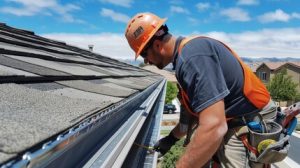Gutters are the often-overlooked guardians that silently protect a home. They channel water away from the roof and foundation, preventing costly structural damage and basement flooding.

Thorough inspection and maintenance can help identify gutter issues that might require cleaning or repairs. Gutter repair helps to prevent future problems like clogs and sagging. Contact All American Gutters and Fences for professional help.
Gutter systems rely on sturdy attachment points to stay in place and channel water toward downspouts. But aging and exposure to the elements can wear down these critical connection points. This makes it necessary to check gutters for signs of loosening. Gutter repair services can fortify these points of vulnerability with waterproof sealants. This prevents leaks and prolongs the life of a gutter system.
In some cases, gutter damage may require a more extensive fix. A crack or split along a gutter channel can expand and cause severe water damage to siding, foundations, or other areas of the home. Professionals patch cracks with caulk and other materials. They also recommend upgrading to seamless gutters, which are less prone to cracking.
Another common problem affecting gutters is sagging sections. This often results from a loss of the natural gutter slope, which channels runoff water toward downspouts. This change can be caused by climate changes, age-related wear and tear, or loose hangers or spikes. Professionals fix sagging gutters by tightening fasteners, replacing or upgrading to stronger brackets, and in some cases rehanging entire sections of gutters. They also evaluate the spacing of these attachment points to ensure they can handle the weight of a full gutter.
Leaks can occur in any gutter section, but they’re most common around joints. This is because these spots are prone to accumulating debris like leaves, twigs, and bird nests. During a regular inspection, gutter services can spot these issues early and address them before they become serious leaks that cause costly damage.
Generally, the best course of action is to replace gutters that show widespread damage or are nearing the end of their lifespan. It’s also wise to consider a more comprehensive maintenance plan, such as adding regular gutter cleaning and inspections. This can save money and time, while also ensuring a well-functioning gutter system that protects your home from potential water damage. This is especially important in areas prone to flooding or where storms are frequent and intense.
Deformed Gutters
When gutters are damaged or sagging, the water that pools in their vicinity can cause serious issues. Gutter damage may affect the roof, walls, foundation, and landscape of your home, requiring extensive and expensive repairs.
To prevent this, it is vital to inspect your gutters regularly and address problems when they are small. Look for rust, cracks, and loose fasteners in addition to sagging sections or visible signs of water damage like water stains. If you see any of these signs, consider scheduling a professional gutter repair service to address the issue before it escalates.
Observing how water behaves during rain is one of the most reliable ways to identify potential gutter repair issues. Water that collects or pools in specific areas of the gutter may indicate incorrect sloping, which can lead to major moisture problems. This often takes the form of puddles or standing water around the base of the house, which can weaken the soil and wash away foundational support over time.
Another common gutter repair issue is paint damage. This typically occurs due to water pooling in the gutter, which causes the paint to bubble or peel. It can also cause rust-colored streaks, which is usually indicative of a deeper problem that needs to be addressed before it gets worse.
Gutters that aren’t extending far enough from the home’s foundation can also pose problems. Water that constantly saturates the ground near the house’s foundation can erode the soil, washing away supporting structures and possibly leading to basement flooding and cracked or warped floors. To avoid this, ensure your gutters extend at least a few feet away from the foundation. You may even want to add gutter splash blocks or underground extensions to further divert water.
Gutter damage can be difficult to spot because it can often occur behind the siding and soffit. However, if you notice any mold, rot, or mildew in these areas, this is a sign that water from the gutter is getting trapped there and creating an ideal environment for the growth of unhealthy organisms. Moisture that seeps into the soffit or fascia can linger undetected, causing wood rot and encouraging the formation of mold and mildew.
Pooling Water
Gutter systems help keep water away from the roof and foundation of a building. This helps protect the roof from water damage and mitigates the risk of basement flooding. They also prevent soil erosion around the home and keep water from seeping into the foundation, which can lead to expensive structural repairs. However, gutters can become clogged or damaged, causing water to pool inside the system. Water pooling can also cause the structure to settle, resulting in cracks and other issues. The best way to prevent water pooling is to perform regular cleaning and maintenance tasks.
Identifying and addressing issues like clogged gutters, rusty fasteners, loose or detaching parts, and water stains are essential for ensuring your gutter system functions properly. If you notice these issues, it’s a good idea to seek professional assistance to ensure your gutters are in good condition and can adequately channel water away from the building.
Clogged gutters prevent the proper flow of rainwater from the roof, which can lead to shingle deterioration and water leaks. It’s crucial to clean out the gutters and downspouts regularly to keep them debris-free.
A poorly functioning gutter system can also cause soil erosion and foundation problems. In areas with expansive clay-based soil, overflowing gutters can cause the soil to become saturated and push against foundation walls. This can result in structural settlement and bowing walls, leaning chimneys, sticking doors and windows, and leaking basements and foundations.
It’s important to invest in gutters that are designed to work in your area. Gutter companies can recommend the best gutter style, slope, and downspout placement for your home’s drainage needs. In addition, they can help you determine the best maintenance and cleaning techniques to keep your gutters working correctly.
Gutter installation mistakes can also affect gutter function, such as improper slope or positioning of downspouts. It’s essential to find a qualified gutter specialist that has experience with the area’s unique weather conditions. Performing routine maintenance and identifying problems early with your gutters can save you money and maintain your home’s value. A well-functioning gutter system is the best defense against costly water damage and can contribute to a safe and healthy living environment.
Water Damage
Gutter leaks and standing water damage compel property owners to make costly repairs that extend beyond the gutters themselves. Clogged gutters allow moisture intrusion that damages drywall, insulation, wood siding, and interior furnishings. Water can also seep into basements, causing damp conditions that can lead to mold, mildew, and structural damage.
Gutters that leak corrode over time through the expansion and contraction that occurs with repeated freeze-thaw cycles and exposure to UV radiation. This process erodes metal and weakens seams, joints, and connections. Over time, the weakened areas expand into cracks and holes that increase in size with each rainfall.
If you notice that your gutters are sagging, you should consider scheduling an immediate repair. This issue signals that the system is under stress from excessive weight, and it could eventually collapse. Gutter systems typically sag due to a combination of factors, including accumulated leaves, twigs, and granules from shingles. Overtime, these materials exert an excessive weight that stretches gutter components and loosens fasteners from anchor points at the fascia board. Other contributing factors include age-related deterioration, and temperature fluctuations that cause expansion and contraction that loosens fasteners.
While DIY approaches may address minor problems like clogs and loose fasteners, significant issues like extensive rust, multiple cracks, and sagging require professional intervention to resolve. Attempting to tackle these problems without the proper skills, tools, and equipment can result in improper solutions that only exacerbate the problem.
Regular maintenance and routine inspections can significantly reduce the likelihood of clogs, overflows, leaks, and other problems that lead to gutter repair. Our team of experts can provide the care and attention that your gutters need to function properly year-round. We can install innovative solutions like gutter guards and larger downspouts to prevent blockages, as well as make sure your gutters are directing water away from your building’s foundation. These preventive measures can save homeowners thousands in repairs and reduce their risk of water damage. Contact us today to schedule a free consultation!

